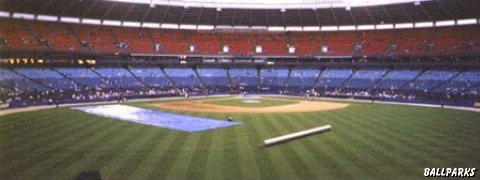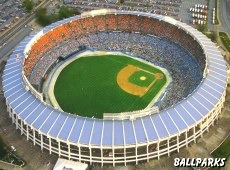Atlanta-Fulton County Stadium
Atlanta, GeorgiaTenant: Atlanta Braves (NL) Architects: Heery & Heery and Finch, Alexander, Barnes, Rothschild & Paschal (both of Atlanta) Atlanta Braves tickets:
Location: Left field (N by NE), Fulton Street and Interstate 20; third base (W by NW), Washington Street, Interstate 75/85, and Pulliam Street; first base (S by SW), Georgia Avenue; right field (E by SE), Capitol Avenue. Dimensions: Foul lines: 325 ft. (1966), 330 ft. (1967); power alleys: 385 ft. (1966), 375 ft. (1969), 385 ft. (1974); center field: 402 ft. (1966), 400 ft. (1969), 402 ft. (1973); backstop: 59.92 ft. (1973); foul territory: large (1966), medium (1977). Fences: 6 ft. (wire, 1966), 10 ft. (4 ft. plexiglass above 6 ft. wire, 1983), 10 ft. (plexiglass, 1985). During the 1990s, 50,000 people sat in the seats of Atlanta-Fulton County Stadium every single night during baseball season, but it wasn’t always such a great spot for baseball. Once the excitement died down after the Braves moved to Atlanta from Milwaukee in 1966, the stadium became infamous for its ghost-town atmosphere. It was there that only 1,762 people turned out to watch the great Nolan Ryan pitch and a mere 970 came to see a Houston Astros-Braves doubleheader in 1976. When new owner Ted Turner arrived in 1976, he decided to stage a promotion every day. What followed were some of the most memorable promotional events in the history of baseball. There was Wedlock and Headlock Day-in which the Braves let 34 couples get married on the field before a game and then staged a pro wrestling match after it. Despite those events, the Braves drew less than a million fans for eight straight seasons in the 1970s. For many years, Atlanta-Fulton County Stadium was also known as the home of baseball’s worst playing surface. The ballpark didn’t even have a full-time groundskeeper until 1989. Before that, it had been tended by a city streets crew. But when Bobby Cox became manager, he and General Manager John Schuerholz changed almost everything about the stadium. The old infield was ripped out and the entire stadium was resurfaced. The NFL Falcons moved out, leaving the sod safe from damage by football cleats. And as the team on the field gradually transformed itself into the National League’s dynasty of the 1990s, this onetime baseball laughingstock suddenly became one of the most electrifying ballparks in the land.
It was there, on October 14, 1992, that the obscure Francisco Cabrera became a cult hero by stroking a game-winning pinch hit with two outs in the ninth inning of Game 7 of the playoff series against the Pirates. The stadium hosted NLCS playoff action in 1991, 1992, and 1993. The first National League playoff game in history was played there on October 4, 1969, and the Cincinnati Reds’ Joe Morgan finished a sensational All-Star Game there in 1972 with a game-winning hit in the 10th inning. Niekro threw the stadium’s only complete-game no-hitter on August 6, 1973. Braves pitchers Gene Garber and Larry McWilliams stopped Pete Rose’s 44-game hitting streak there on August 1, 1978, and on July 6, 1986, Atlanta’s Bob Horner became the first man in history to hit four home runs in a game his team managed to lose. On April 8, 1974, Hank Aaron slammed a pitch from the Los Angeles Dodgers’ Al Downing over the left field fence for the 715th homer of his storied career, lifting Aaron past Babe Ruth for the all-time home run lead. The Braves moved across the parking lot to Turner Field following the 1996 Olympic Games. Trivia:
More on Atlanta-Fulton County Stadium: Recommended Reading (bibliography):
Help us provide a better web site by completing our feedback form PHOTOGRAPHS: View inside Atlanta-Fulton County Stadium © 1996 by Munsey & Suppes and Ray Bergman. Updated April 2007 Tickets to Atlanta Braves, NCAA Basketball Tournament, College Football Bowl, NCAA Football, Carolina Panthers, Paul McCartney and Wicked Atlanta provided by Ticket Triangle. BALLPARKS © 1996-2014 by Munsey & Suppes.
|








